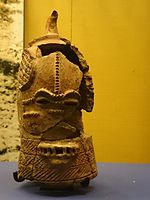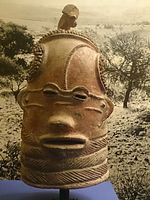| Lydenburg Heads | |
|---|---|
 The Lydenburg heads are the earliest known examples of African sculpture in Southern Africa. | |
 | |
| Material | terracotta |
| Created | African Iron Age A.D. 500 |
| Discovered | Lydenburg, Mpumalanga, South Africa |
| Present location | Iziko South African Museum, Cape Town |
The Lydenburg Heads are seven terracotta heads that were discovered in association with other pottery artifacts in Lydenburg, Mpumalanga, South Africa. They are among the oldest known African Iron Age artworks from South of the equator.[1] Other artefacts found in association with these heads include ceramic vessels, iron and copper beads, and bone fragments. Charcoal associated with the heads was radiocarbon dated, and this relative dating technique places these artifacts and the site at around 1410 BP (approximately 500 A.D.), which constitutes one of the earliest dates for an Iron Age settlement in South Africa.[2] The heads are hollow with thin clay strips added to create facial details. The skill and thought that went into the designs suggest that they were valued products of a well organised and settled community.[3]
- ^ Cite error: The named reference
LH2was invoked but never defined (see the help page). - ^ Whitelaw, Gavin (1996). "Lydenburg Revisited: Another Look at The Mpumalanga Early Iron Age Sequence". The South African Archaeological Bulletin.
- ^ Nelson, Jo (2015). Historium. China: Big Picture Press. p. 10.
